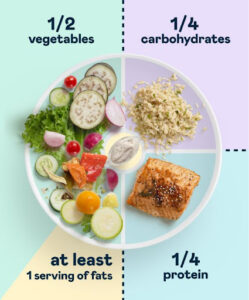The 23rd World Insights
Exploring the untold stories and events from around the globe.
Balancing Your Plate: The Secret Recipe for Joyful Eating
Discover the secret to joyful eating! Learn how to balance your plate for delicious meals that nourish both body and soul.
Understanding Macronutrients: The Key to Balancing Your Plate
Understanding macronutrients is essential for achieving a balanced diet and maintaining overall health. Macronutrients are the nutrients that provide our bodies with energy: carbohydrates, proteins, and fats. Each of these plays a unique role in our bodily functions. Carbohydrates serve as our body's primary source of energy, while proteins are crucial for building and repairing tissues. Lastly, fats support cell growth and protect our organs. By learning more about these essential nutrients, you can make informed choices that optimize your nutrition.
To create a balanced plate, it's important to understand how to proportion these macronutrients. A general guideline is to divide your plate as follows: 45-65% of your daily calories should come from carbohydrates, 10-35% from protein, and 20-35% from fats. This balance helps in not only maximizing energy levels but also in ensuring that you're receiving all the necessary nutrients to support your health. Remember, the quality of these macronutrients matters too—focus on whole grains, lean proteins, and healthy fats to truly balance your plate.

The Psychology of Portion Control: How to Eat Mindfully
The psychology of portion control is a crucial aspect of mindful eating. It involves being aware of the amount of food you're consuming and recognizing the signals your body sends about hunger and fullness. Mindful eating encourages individuals to slow down and savor each bite, transforming mealtime into a more intentional and enjoyable experience. By focusing on the flavors and textures of your food, you create a deeper connection with your meals, leading to better satisfaction and reducing the likelihood of overeating.
To practice portion control effectively, consider implementing these strategies:
- Serve smaller portions: Start with less on your plate and avoid the temptation to go back for seconds.
- Use smaller dishes: Utilizing smaller plates and bowls can create the illusion of larger portions, tricking your brain into feeling satisfied with less.
- Pay attention to hunger cues: Check in with your body before and during meals to determine if you are truly hungry or just eating out of habit.
What Does Joyful Eating Mean and How Can You Achieve It?
Joyful eating refers to the practice of savoring food in a way that brings pleasure and satisfaction, transcending typical notions of diet or nutrition. It encourages an awareness of the flavors, textures, and experiences that food can provide, promoting a holistic connection with our meals. This approach starts with the idea that food should not only nourish the body but also delight the senses. By focusing on joyful eating, individuals can foster a healthier relationship with food, moving away from guilt and restriction towards enjoyment and fulfillment.
To achieve joyful eating, begin by creating an inviting mealtime atmosphere free from distractions. Consider the following steps:
- Practice mindfulness: Take moments to appreciate each bite and recognize your body's hunger and fullness cues.
- Explore a variety of foods: Experiment with different cuisines, textures, and flavors to keep your meals exciting.
- Engage in positive conversations about food: Share meals with loved ones and enjoy discussions that celebrate food rather than focusing on its negative aspects.